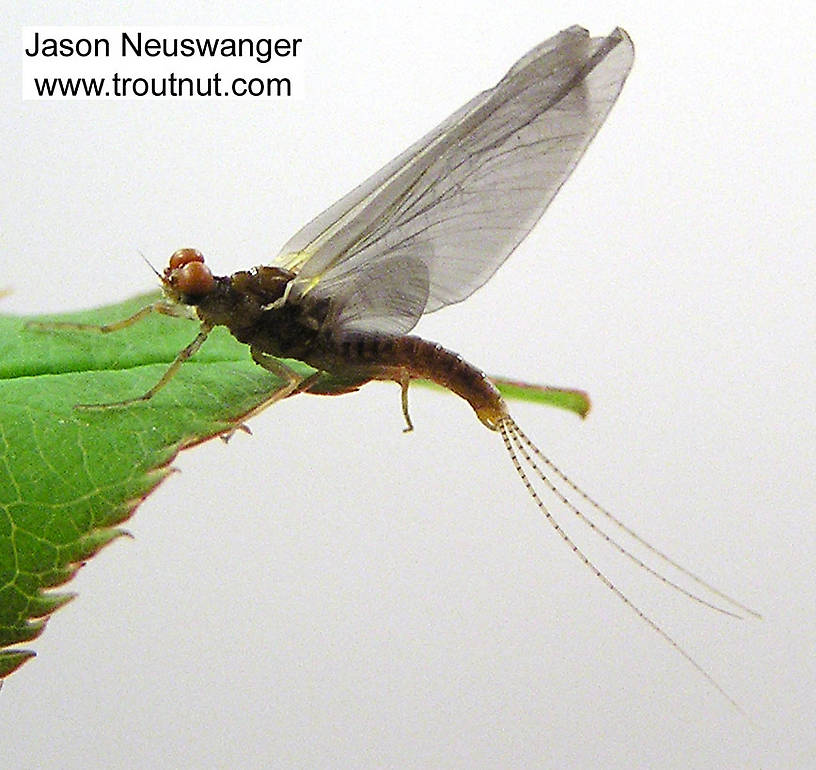
Salmonflies
Pteronarcys californica
The giant Salmonflies of the Western mountains are legendary for their proclivity to elicit consistent dry-fly action and ferocious strikes.
Featured on the forum

This one seems to tentatively key to Holocentropus, although I can't make out the anal spines in Couplet 7 of the Key to Genera of Polycentropodidae Larvae nor the dark bands in Couplet 4 of the Key to Genera of Polycentropodidae Larvae, making me wonder if I went wrong somewhere in keying it out. I don't see where that could have happened, though. It might also be that it's a very immature larva and doesn't possess all the identifying characteristics in the key yet. If Holocentropus is correct, then Holocentropus flavus and Holocentropus interruptus are the two likely possibilities based on range, but I was not able to find a description of their larvae.

Troutnut is a project started in 2003 by salmonid ecologist Jason "Troutnut" Neuswanger to help anglers and
fly tyers unabashedly embrace the entomological side of the sport. Learn more about Troutnut or
support the project for an enhanced experience here.
Martinlf on Aug 17, 2007August 17th, 2007, 5:38 am EDT
Would some of the entomologists on the site comment on the color of this sulphur dun? I was scanning through the images, planning on doing some dyeing, and this one caught my attention as it is so much darker than others.
"He spread them a yard and a half. 'And every one that got away is this big.'"
--Fred Chappell
--Fred Chappell
Wiflyfisher on Aug 17, 2007August 17th, 2007, 6:24 am EDT
Louis, I would suspect the little bugger was in the sun too long and got a bad sunburn.
John S.
https://WiFlyFisher.com
https://WiFlyFisher.com
CharlieSawd on May 22, 2009May 22nd, 2009, 5:07 pm EDT
Jason,
Is this not subvaria?
Is this not subvaria?
Charlie Sawdey
www.driftlessflybox.com
www.driftlessflybox.com
Konchu on May 23, 2009May 23rd, 2009, 7:25 am EDT
that one might be subvaria rather than invaria, but it is sometimes hard to tell from the dun which one it is. for those other two or three of you who track such things: an old, obscure mayfly paper by Ide from the 1930s discussed this problem and his observations.
invaria has a couple of color forms in MN; one is really dark. so, some think that these are invaria and rotunda. someone from here is going to send me some of these from a single stream for DNA analysis and comparison to other populations to put this to the test.
invaria has a couple of color forms in MN; one is really dark. so, some think that these are invaria and rotunda. someone from here is going to send me some of these from a single stream for DNA analysis and comparison to other populations to put this to the test.
CaseyP on May 23, 2009May 23rd, 2009, 7:39 am EDT
maybe this little guy is back-lit, which might make him less than lemon yellow. the edges look kind of paler.
"You can observe a lot by watching." Yogi Berra
Wiflyfisher on May 23, 2009May 23rd, 2009, 8:50 am EDT
Since Jason and I fished the same river back then (I still do, but Jason decided he wanted longer winters and left), the chances of that being subvaria male dun are very slim, based on "Collected May 22, 2004".
My uneducated $.02.
My uneducated $.02.
John S.
https://WiFlyFisher.com
https://WiFlyFisher.com
GONZO on May 23, 2009May 23rd, 2009, 4:02 pm EDT
Louis,
We often assume too much about color based on individual photographs and the name "sulphur." Although the term suggests a general coloration, it doesn't reflect color variation within a species, sexually dimorphic color differences, or the darkening that takes place after emergence. All of these factors probably have some bearing on the color of this specimen. We expect sulphurs to be yellow, but invaria males are typically darker than the females--often some shade of brown (as are many female invaria spinners). Some fly-fishing books tend to perpetuate the notion that all sulphurs are yellow by picturing only the yellowish female duns. In addition, photos often show duns in various stages of darkening after emergence.
I agree with John that the collection date seems too late for subvaria, but it would be nearly impossible to prove a species ID from the photographs alone. However, I also can't see a way to rule out the possibility that this might be E. excrucians. That species is probably more common in the Midwest than it is in the East.
If that were the case, it might also explain this:
http://www.troutnut.com/specimen/745
Jason was confused by the color of the eggs in the picture, but most PA fly fishers will attest that invaria eggs are typically yellow to orange. Personally, I have never seen a green egg sack on invaria in my part of the East. This spinner and her eggs are fairly typical of the female invaria spinners that I see. Although it is just speculation on my part, perhaps some of the Midwestern "sulphurs" (especially the "olive" ones known as "Kinni sulphurs") are excrucians rather than invaria. And maybe, just maybe, the male dun in question is excrucians.
We often assume too much about color based on individual photographs and the name "sulphur." Although the term suggests a general coloration, it doesn't reflect color variation within a species, sexually dimorphic color differences, or the darkening that takes place after emergence. All of these factors probably have some bearing on the color of this specimen. We expect sulphurs to be yellow, but invaria males are typically darker than the females--often some shade of brown (as are many female invaria spinners). Some fly-fishing books tend to perpetuate the notion that all sulphurs are yellow by picturing only the yellowish female duns. In addition, photos often show duns in various stages of darkening after emergence.
I agree with John that the collection date seems too late for subvaria, but it would be nearly impossible to prove a species ID from the photographs alone. However, I also can't see a way to rule out the possibility that this might be E. excrucians. That species is probably more common in the Midwest than it is in the East.
If that were the case, it might also explain this:
http://www.troutnut.com/specimen/745
Jason was confused by the color of the eggs in the picture, but most PA fly fishers will attest that invaria eggs are typically yellow to orange. Personally, I have never seen a green egg sack on invaria in my part of the East. This spinner and her eggs are fairly typical of the female invaria spinners that I see. Although it is just speculation on my part, perhaps some of the Midwestern "sulphurs" (especially the "olive" ones known as "Kinni sulphurs") are excrucians rather than invaria. And maybe, just maybe, the male dun in question is excrucians.
Wiflyfisher on May 23, 2009May 23rd, 2009, 4:31 pm EDT
Jason does have some photos of Ephemerella excrucians nymphs he collected. I am believe on the same river.
http://www.troutnut.com/hatch/459/Mayfly-Ephemerella-excrucians-Pale-Morning-Dun.
http://www.troutnut.com/hatch/459/Mayfly-Ephemerella-excrucians-Pale-Morning-Dun.
John S.
https://WiFlyFisher.com
https://WiFlyFisher.com
CharlieSawd on May 23, 2009May 23rd, 2009, 4:31 pm EDT
Gonzo,
I am not sure where Jason collected this specimen, but the majority of "Sulphurs" or "PMD's" found on the Kinni and the Rush in Western WI are E. excrucians (sorry have not figured out the italics here yet). And I do agree that E. subvaria hatches in West Central WI are sparse, however, they are not unheard of. Late May is not too late, (again, depending on locale of specimen collection) for E. subvaria to emerge. I am convinced that this is not E. invaria, but am not sure if it is excrucians or subvaria.
Jason, help us. Where was this collected?
I am not sure where Jason collected this specimen, but the majority of "Sulphurs" or "PMD's" found on the Kinni and the Rush in Western WI are E. excrucians (sorry have not figured out the italics here yet). And I do agree that E. subvaria hatches in West Central WI are sparse, however, they are not unheard of. Late May is not too late, (again, depending on locale of specimen collection) for E. subvaria to emerge. I am convinced that this is not E. invaria, but am not sure if it is excrucians or subvaria.
Jason, help us. Where was this collected?
Charlie Sawdey
www.driftlessflybox.com
www.driftlessflybox.com
GONZO on May 24, 2009May 24th, 2009, 6:45 am EDT
Thanks for the info on excrucians in the Kinni and the Rush, Charlie, but I'm inclined to think that this probably is invaria. I just realized that the ruler in the picture is English rather than metric, so the size is probably more consistent with invaria or subvaria. After looking at many of the specimens that Jason collected at about the same time, I think we are probably looking at a slightly dark (but not unusual) population of invaria. Consider these female duns collected the on the 23rd:
http://www.troutnut.com/specimen/180
http://www.troutnut.com/specimen/182
And then compare the male collected on the 23rd to the one collected on the 22nd:
http://www.troutnut.com/specimen/179
When I compare Jason's Midwestern specimens of invaria to those he collected in PA, his Midwestern female duns tend to be more of a greenish yellow shade (Louis mentions this in his question about specimen 180) and the males a bit darker. Perhaps the green eggs that Jason mentioned are more prevalent in some Midwestern specimens than in the more yellowish or orangish specimens that I am accustomed to seeing in PA.
http://www.troutnut.com/specimen/180
http://www.troutnut.com/specimen/182
And then compare the male collected on the 23rd to the one collected on the 22nd:
http://www.troutnut.com/specimen/179
When I compare Jason's Midwestern specimens of invaria to those he collected in PA, his Midwestern female duns tend to be more of a greenish yellow shade (Louis mentions this in his question about specimen 180) and the males a bit darker. Perhaps the green eggs that Jason mentioned are more prevalent in some Midwestern specimens than in the more yellowish or orangish specimens that I am accustomed to seeing in PA.
Wiflyfisher on May 24, 2009May 24th, 2009, 3:08 pm EDT
Charlie for italics use bracket "[-i-]" add word(s) "[-/i-]". Remove the "-" signs.
I believe in May, 2004 Jason was shooting bugs on the Namekagon River. The Namekagon River heats up much faster than the other NW corner trout streams.
I believe in May, 2004 Jason was shooting bugs on the Namekagon River. The Namekagon River heats up much faster than the other NW corner trout streams.
John S.
https://WiFlyFisher.com
https://WiFlyFisher.com
Quick Reply
Related Discussions
Topic
Replies
Last Reply
0
Jun 29, 2020
by Wiflyfisher
by Wiflyfisher
4
May 17, 2010
by Lastchance
by Lastchance
1
Aug 21, 2007
by Gene
by Gene
Re: Will the real Ephemerella needhami please stand up? Featured Topic
In Male Ephemerella needhami Mayfly Dun by GONZO
In Male Ephemerella needhami Mayfly Dun by GONZO
17
Feb 26, 2016
by Martinlf
by Martinlf






